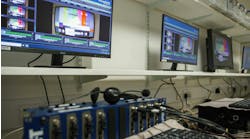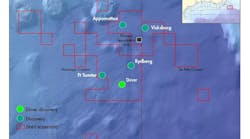J & S Marine Ltd., a UK-based marine electrical and design/engineering company, has produced an innovative solution to the problem of directly measuring subsea loads. The loads can be diverse in nature and so can the methods of monitoring and displaying the data itself in a useful form. The common factor is normally that the raw data will need to be processed and viewed at the surface. Getting it there can often be a problem as the cables or fibers carrying the data can be difficult to install and are liable to breakage.
All-in-one shackle.
The proposed system is currently undergoing final trials and will be available commercially later in 2006. It is based on a shackle that can interconnect chains and cables, moorings and liftlines, and also houses a load cell and data transmission system. The entire assembly has a safe working load of 600 tons (although higher and lower ratings are available). The shackle also houses a power pack with an acoustic transponder (see drawing). Both systems are diver or ROV replaceable and can be supplied to operate down to 10,000 ft. Under optimal conditions of depth and sampling frequency, battery life before replacement is around 10 years.
The load cell system was originally designed for monitoring the mooring spreads of floating production systems. These offshore systems have an anchor spread of 9-12 cables, typically with a chain at the upper end and either continuing to the seafloor (particularly in shallower water) or joining on to synthetic mooring lines that continue down to the anchoring systems on the seabed.
Traditionally, to monitor such systems, load cells are used. These are placed on the chains where they meet on board the vessel and, as a result, are very likely to be damaged. Usually the cells themselves are not damaged or destroyed but the wires carrying the data become disconnected or broken; whatever happens, monitoring capability is lost. If the load data is lost, replacement units are not cost effective and may have a working life of only a few months.
An alternative is to assess the load indirectly by measuring the angle of the chains as they run out from the vessel and into the water. Simple and reliable, but cannot be considered as a direct measurement.
The J&S Marine basic mooring monitoring system would typically have a load cell on each mooring line at around 330 ft depth either within the chain or at the chain/synthetic line junction. The load data is transmitted acoustically to the vessel via the integral acoustic system and is typically downloaded at least once a day although the user can choose to do this more frequently. Sampling is also user selectable but is typically every 3 seconds. Each load cell system transmits its data with an identification tag to a subsea transponder/modem on the FPS hull. Although data would normally be sent on a daily basis, this can become continuous transmission when required because it is user selectable. The received data is then passed to a central processor aboard the vessel where it is analyzed and displayed, allowing the operating crew to monitor stress on each line and ensure even load spread and correct vessel orientation.




